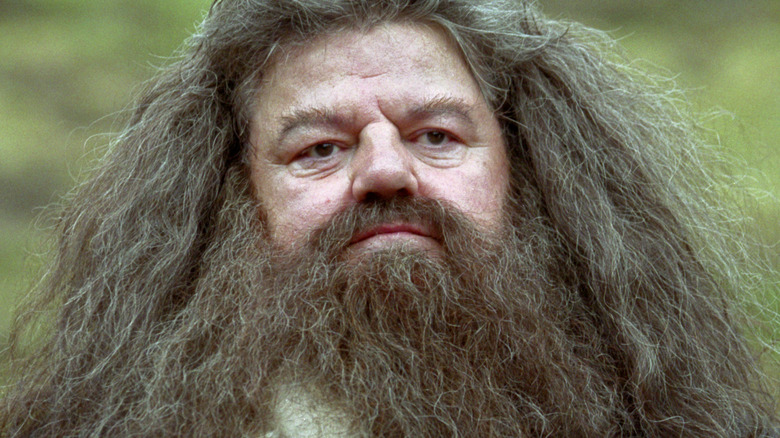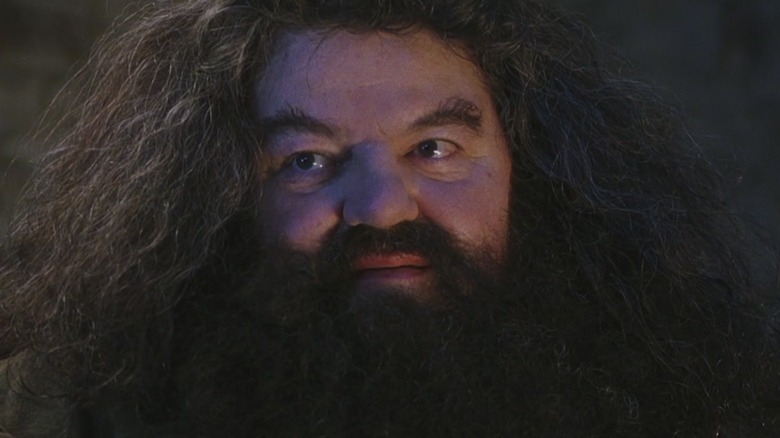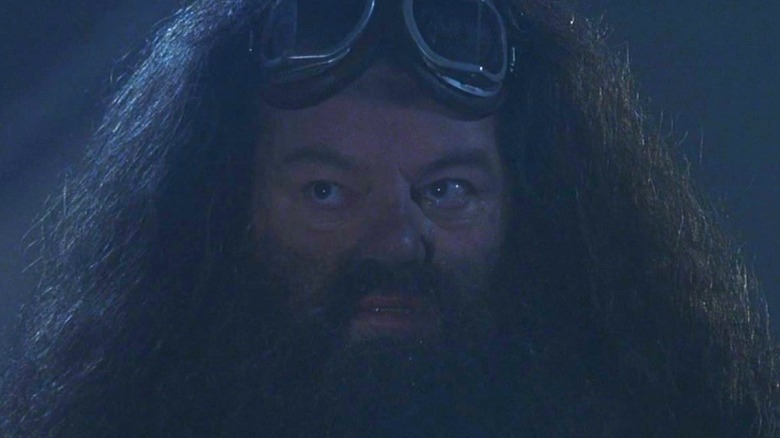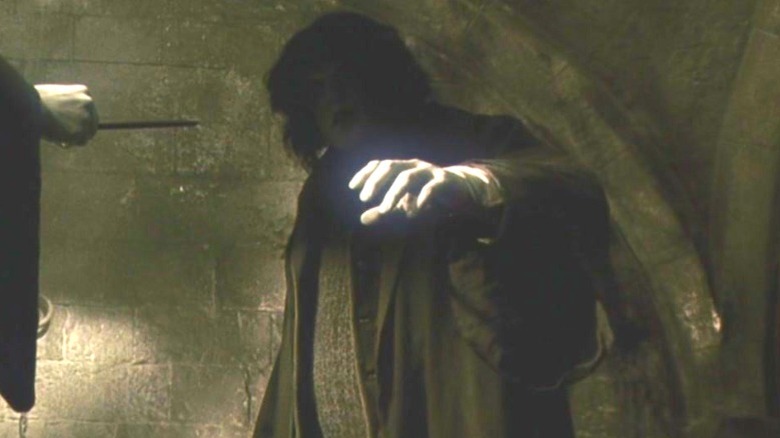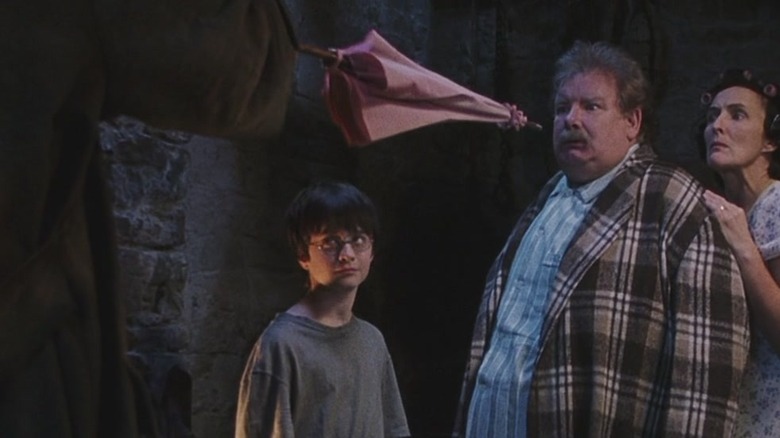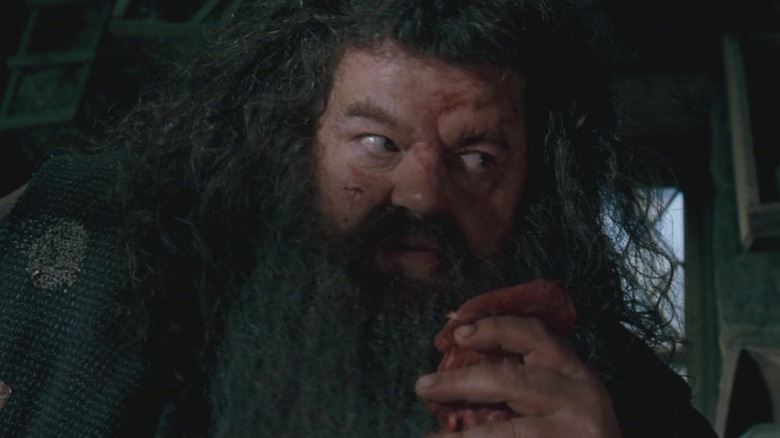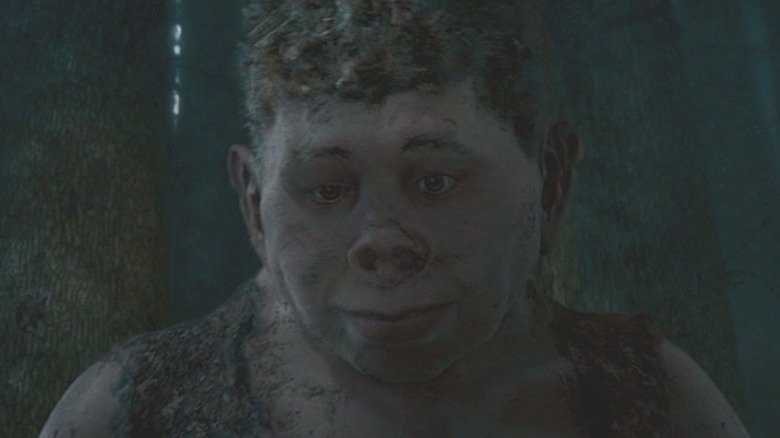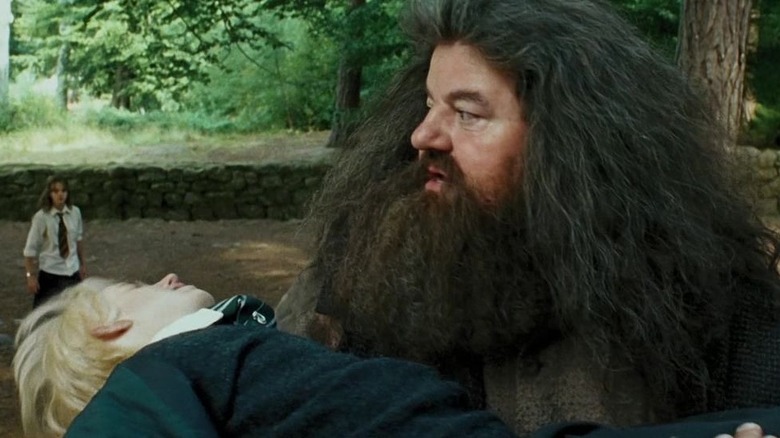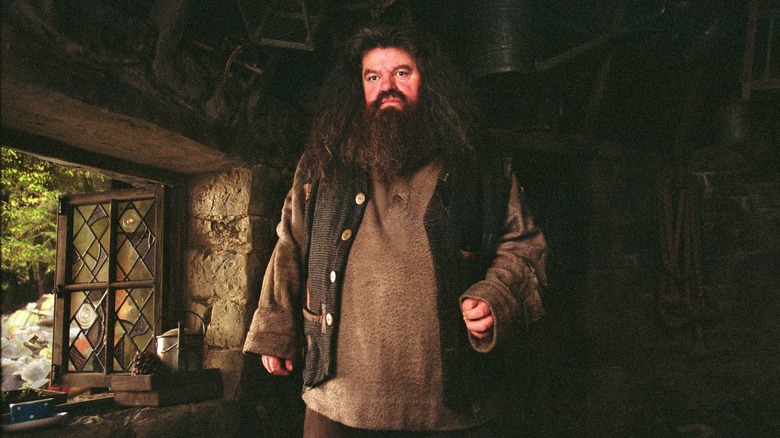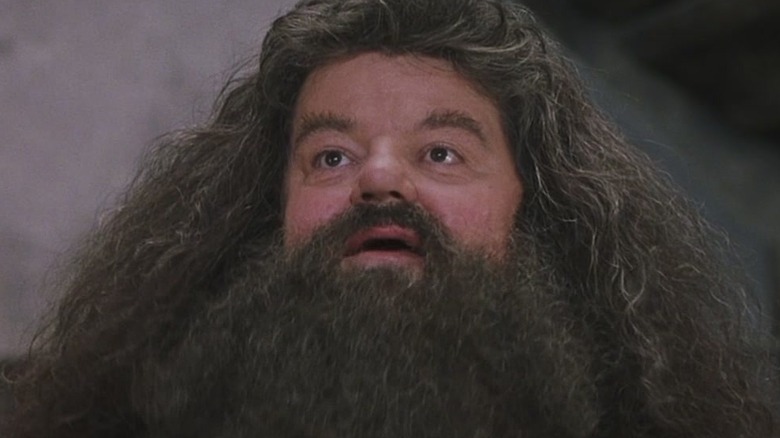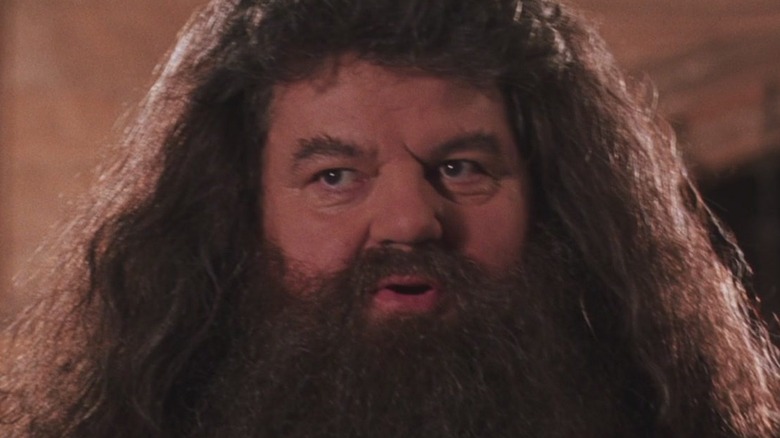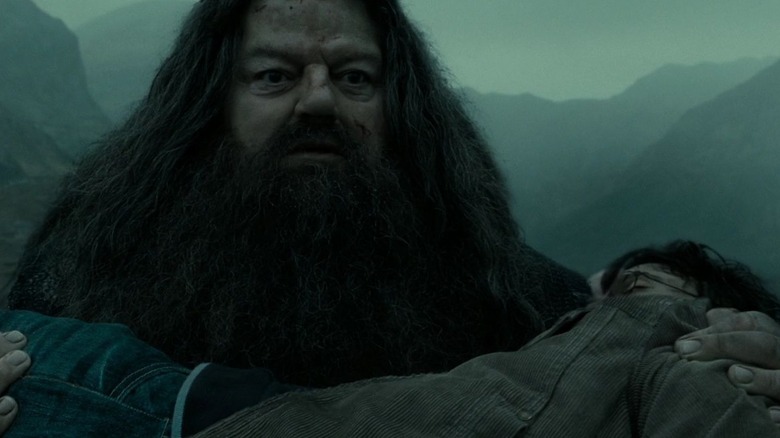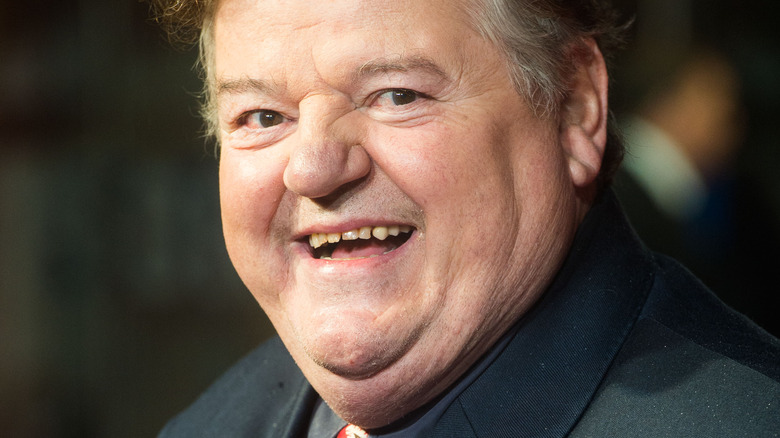The Spellbinding History Of Rubeus Hagrid From Harry Potter
Harry Potter was lucky enough to have several understanding adults in his corner over the course of the "Harry Potter" franchise. From Albus Dumbledore serving as his mentor to Professor McGonagall giving him the support he needed at all times, wizarding adults shaped Harry through his formative years. One of them in particular, Rubeus Hagrid, was a close friend and supporter of the Boy Who Lived.
The groundskeeper of Hogwarts introduced Harry to the wizarding world, explaining Hogwarts and showing him all the shops of Diagon Alley. Hagrid was always there for Harry, to the very end. Robbie Coltrane portrayed him in the films, bringing the magic of the gentle giant to life by capturing his personality perfectly, even while wearing a fake beard.
While some may brush Hagrid off as an "oaf," or consider him not qualified enough to teach (looking at you, Draco Malfoy), there is so much more behind the character. From his ancestry to the source of his inspiration, we're leaving no stone unturned. Grab a lantern as we venture into the Forbidden Forest to follow the spiders as they lead us to the captivating history of Rubeus Hagrid.
He is half-giant
When Hagrid is first introduced in "Harry Potter and the Sorcerer's Stone," he is referred to as a giant. Then, when Harry finally meets him in the fourth chapter of the book, Harry calls him a giant again, telling himself, "I dreamed a giant called Hagrid came to tell me I was going to a school for wizards."
It isn't until "Harry Potter and the Goblet of Fire" that it's revealed Hagrid isn't a giant: He's a half-giant. When Ron and Harry are walking on the castle grounds during the Yule Ball, they stumble upon Hagrid speaking with Madame Olympe Maxime, the headmistress of the Beauxbatons Academy of Magic. He believes she is a half-giant, and asks her about it, inadvertently offending her.
Due to Harry's upbringing, Ron has to explain why the headmistress would be offended by the statement. "They're just vicious, giants," Ron states. "They're like trolls ... they just like killing, everyone knows that."
We learn then that Hagrid's mother was a giant. Fridwulfa had Hagrid with his human father, who remains unnamed. She stayed until Hagrid was three years old, then chose to return to a giant colony. Hagrid has very few memories of his mother. After losing one parent as a small child, his father died just after he started at Hogwarts, making him an orphan at a young age, as we discover in "Harry Potter and the Goblet of Fire."
He saved baby Harry from the wreckage at Godric's Hollow
After Voldemort kills James and Lily Potter on October 31, 1981, Hagrid is sent to retrieve baby Harry by Dumbledore. Professor McGonagall doesn't necessarily agree with his decision, asking the headmaster if he thought it was "wise" to give Hagrid that kind of responsibility. "I would trust Hagrid with my life," is Dumbledore's response in "Harry Potter and the Sorcerer's Stone."
The half-giant rolls up on a large motorcycle, later revealed to belong to Sirius Black, Harry's godfather. "I got him out all right before the Muggles started swarmin' around," Hagrid tells the professors. He is upset that he has to leave Harry with the Dursleys, crying over what happened to the Potters and that Harry would have to live with Muggles until he was old enough to attend Hogwarts.
It's only fitting that Hagrid is the one sent to take Harry to Diagon Alley, especially after the Dursleys try to run from the letters granting their nephew admission to Hogwarts. He buys Harry his pet owl, Hedwig, and makes sure he gets all the supplies he would need to begin his wizarding education.
He was expelled from Hogwarts
While Hagrid attended Hogwarts, he never graduated. Rowling revealed in a live chat hosted by Barnes and Noble and Yahoo! in 2000 that he was sorted into Gryffindor while he was a student (archived by Accio-Quote).
Hagrid only made it halfway through his wizarding education. During his third year, the Chamber of Secrets was opened, leading to the death of Myrtle Warren, a Ravenclaw student who spent her afterlife haunting a bathroom as "Moaning Myrtle." It was around this time that Hagrid obtained Aragog, a large magical spider known as an Acromantula. When Harry and Ron meet Aragog in "Harry Potter and the Chamber of Secrets," the spider describes how he came to be with the half-giant student. "A traveler gave me to Hagrid when I was an egg," he shares. "Hagrid was only a boy, but he cared for me."
As a student, Hagrid was accused of opening the Chamber and using Aragog to petrify and kill students. He was set up by Tom Riddle, aka Voldemort, when he was still a student, who was the actual perpetrator of the crimes. When Harry speaks with Tom in the Chamber of Secrets, the Dark wizard reveals that after Hagrid was expelled, Dumbledore convinced the then-headmaster Armando Dippet to let Hagrid continue living there, taking on the role of groundskeeper.
Hagrid's name is cleared when the Chamber of Secrets is reopened during Harry's second year at Hogwarts, but it is sadly too late by then for him to formally finish his education.
Where he keeps his wand
When Hagrid was expelled from Hogwarts, his wand was snapped in two. As Hagrid takes Harry to purchase a wand in "Harry Potter and the Sorcerer's Stone," Mr. Ollivander remembers the wand he had sold him all those years before. "Oak, sixteen inches, rather bendy, wasn't it," he asks. "But I suppose they snapped it in half when you got expelled?" Hagrid confirms the wandmaker's assumptions, and we learn that he has kept the pieces of his broken wand. "But you don't use them?" Ollivander presses. Hagrid responds that he didn't, but Harry "noticed he gripped his pink umbrella very tightly as he spoke."
The pieces of Hagrid's broken wand are encased in the pink umbrella, as we see when he aims it at Dudley to give him a pig tail. Of course, Hagrid never finished his schooling, so he doesn't have the knowledge to do many spells, and a broken wand doesn't work as well as a whole one.
In Mr. Ollivander's notes on wand woods, he states that wands made of oak are attracted to witches or wizards that have "strength, courage and fidelity." Individuals with oak wands tend to have an affinity for the natural world, which describes Hagrid perfectly (via Wizarding World).
Dumbledore sent him on a mission
Harry, Ron, and Hermione are surprised when they return to Hogwarts for their fifth year and Hagrid isn't on the platform as students exit the Hogwarts Express. Instead, Professor Grubbly-Plank, a substitute Care of Magical Creatures professor, is there to take the first-year students across the lake.
Hagrid isn't gone the entire school year. He comes back in November, and Harry, Ron, and Hermione excitedly visit him as soon as they learn of his return. But Hagrid is in bad shape, covered in bruises, with his left eye swollen and discolored, and moving as though he had broken ribs. Despite the barrage of questions that come from his young friends, Hagrid won't tell them what happened to him, merely putting a dragon steak over his eye to help with the swelling.
They admit they know he was probably with giants, and he confirms it. Dumbledore sent him and Madame Maxime to a giant colony in hopes of preventing them from joining forces with Voldemort. They were mostly successful, convincing their leader Karkus, to side with the light. However, two Death Eaters convinced another giant, Golgomath, to side with the Dark wizards. Golgomath showed up and killed Karkus, taking over his position and dismantling the work Hagrid and Madame Maxime had done, barely allowing them to make it out alive.
He has a half-brother
Hagrid wasn't an only child, though he didn't know it until he was an adult. After his mother left him and his father when he was a toddler, she went on to have another child. Her second son, named Grawp, was a full giant, standing about 16 feet tall.
Hagrid discovers his half-brother while he is on a mission in the giant colony for Dumbledore. Hagrid brings Grawp back to Hogwarts with him, rehoming him to the Forbidden Forest. When it looks like Hagrid has to leave the school in "Harry Potter and the Order of the Phoenix," he takes Harry and Hermione to meet Grawp so someone would know that the giant was there, even if Hagrid was gone.
Their introduction goes less than swimmingly, with Grawp picking Hermione up. It takes some convincing for him to set her back down. Hermione can't understand why Hagrid would bring him back, especially after he said no giants wanted to make the journey. "They were all bullin' him, Hermione, 'cause he's so small," Hagrid explains.
It is revealed by Aberforth in "Harry Potter and the Deathly Hallows" that Hagrid and Grawp hid in a cave near the school after the groundskeeper was nearly arrested for throwing a Support Harry Potter party, and the two brothers participate in the Battle of Hogwarts.
He became a professor at Hogwarts
Though he spends decades being the groundskeeper, in Harry's third year, Hagrid moves into a new role. During the Welcome Feast, Dumbledore announces that Hagrid is taking over the role of Care of Magical Creatures professor. The previous professor, Professor Kettleburn, retired so he could "enjoy more time with his remaining limbs."
Hagrid begins by catching everyone off guard, assigning a textbook that would bite the reader. "The Monster Book of Monsters" is a particularly aggressive book, with students using Spellotape and belts to keep it shut. Hagrid is surprised they hadn't realized how to open their books, noting, as though it were obvious, "yeh've got ter stroke 'em."
After that hold-up, he shows the class the "great" first lesson he planned. He introduces them to the stunning (if haughty) hippogriffs. The lesson doesn't go well, with Draco Malfoy injuring himself because he didn't follow instructions. The school governors, including Draco's father Lucius, are informed, and Hagrid is convinced he would lose his job. He does have to go to a hearing, which results in the decision to execute Buckbeak, the hippogriff responsible for the injury. Harry and Hermione cleverly spare its life at the end of "Harry Potter and the Prisoner of Azkaban."
After the drama of his first lesson, he chooses to teach about simpler creatures, like Flobberworms. Harry notes that they are "some of the most boring creatures in existence."
He (illegally) created a new magical creature
In "Harry Potter and the Goblet of Fire," Hagrid is back to teaching with confidence. But, he is also breeding magical creatures together to make a new one. This goes against the Ban on Experimental Breeding, which was passed in 1965 by the Ministry of Magic ("Fantastic Beasts and Where to Find Them"). The ban makes the creation of any new magical species illegal.
During a Care of Magical Creatures lesson, Hagrid introduces students to Blast-Ended Skrewts. The students had never heard of them, which makes sense, because Hagrid invented them. As part of a year-long project in the course, students are tasked with feeding, walking, and taking care of the creatures, mostly due to Hagrid not knowing what they would eat or how they would behave. They grow rapidly and begin to kill each other as the year goes on.
Rita Skeeter, a wizarding journalist, reveals in an article for The Daily Prophet that they are the result of breeding manticores with fire crabs. She acidly comments that the professor must believe "himself to be above such petty restrictions" as the Ban on Experimental Breeding.
Blast-Ended Skrewts have an appearance similar to scorpions, with a large stinker on their rear and exoskeletons that could repel magic. They grow as long as ten feet, and are seen wreaking havoc during the Triwizard Tournament.
He could never cast a Patronus
A broken wand and incomplete education make it difficult for the groundskeeper to do any magic. But, like many witches and wizards, he also can't cast a spell that Harry in particular excelled with.
Hagrid could never cast the Patronus Charm. This charm is used to repel Dementors, which can use their kiss to suck the soul from a person's body. When asked on Twitter in 2015 what Hagrid's Patronus was, Rowling tweeted that he couldn't produce one, simply typing "it's a very difficult spell" (via Twitter). This isn't a slight against the wizard — while it's true that he didn't complete his education, many fully-trained wizards can't cast the spell correctly.
The Patronus Charm is hard for most, with many only ever able to produce an incorporeal version (via Wizarding World). In that case, it appears as "a mass or wisp of silvery vapour or smoke." The charm isn't only used to defend against Dementors, either. It can be used to send messages, as we see in "Harry Potter and the Deathly Hallows" when Kingsley Shacklebolt sends his Patronus to Bill and Fleur's wedding to warn everyone that the Ministry of Magic had fallen.
Who the character was based on
Rowling shared with Coltrane who inspired the character that he would bring to life on the big screen. Hagrid rode in on a motorcycle when he was introduced in "Harry Potter and the Sorcerer's Stone," so it should come as no surprise that the character is based on a biker that the author knew (via Wizarding World). In an interview for the companion book "Harry Potter: Page to Screen: The Complete Filmmaking Journey," Robbie Coltrane shared what the author told him about the biker.
Hagrid was based on a "Hell's Angel she knew in the West Country," he said. Rowling described the gentleman as "huge and terrifying." But, like Hagrid, there was a soft spot behind the rough exterior. "And then he would sit down and talk about his garden and how his petunias had been very bad that year," Coltrane recalled in the interview. A gardening Hell's Angel? That perfectly describes what the Muggle counterpart of Hagrid's character would look like.
The author knew from the start that Hagrid would carry Harry
After the release of "Harry Potter and the Deathly Hallows – Part 2," J.K. Rowling shared quite a bit of information about her writing process and original plans for the series in a featurette on the film's Blu-ray release. Some were more scandalous, like the fact that she considered killing off Ronald Weasley, but others were about who was initially going to survive the Battle of Hogwarts (like Remus Lupin, the werewolf and Defense Against the Dark Arts professor who was a friend to James Potter).
She knew from the beginning how Harry's final moments would play out. Specifically, Hagrid would be the one to carry a lifeless Harry out of the Forbidden Forest after a "death" Harry went towards willingly (via Entertainment Weekly). When speaking with Daniel Radcliffe in the featurette, she describes that the image of Hagrid carrying Harry had been with her all those years, bringing the series full circle since the half-giant carried Harry away from Godric's Hollow. "That image kept him safe," Rowling says, meaning Hagrid may have died if that plan wasn't in place for him.
Robbie Coltrane was in the author's dream cast
Like many authors, Rowling had an idea of which actors and actresses she wanted to see play her characters on screen. In an interview with journalist Iain Johnstone, as reported by The Telegraph, the author discussed her dream cast and how she felt about the group of actors that was eventually assembled.
"I did get a lot of my dream cast," she said. "But absolutely top of the list: Robbie Coltrane for Hagrid and Maggie Smith for McGonagall." She continued, noting that she felt Coltrane "perfectly" encapsulated the "toughness underneath" of the character.
In an interview with the BBC in 2007, Coltrane noted that after his children heard Rowling wanted him to play Hagrid, they put some pressure on him to take the role. "I think if I hadn't done it I would've been found dead in a ditch," he laughed. He saw the character as two-sided, especially because of the half-giant part of him. The actor tried to make sure there was no "Disney cutesiness" behind the character, though.
